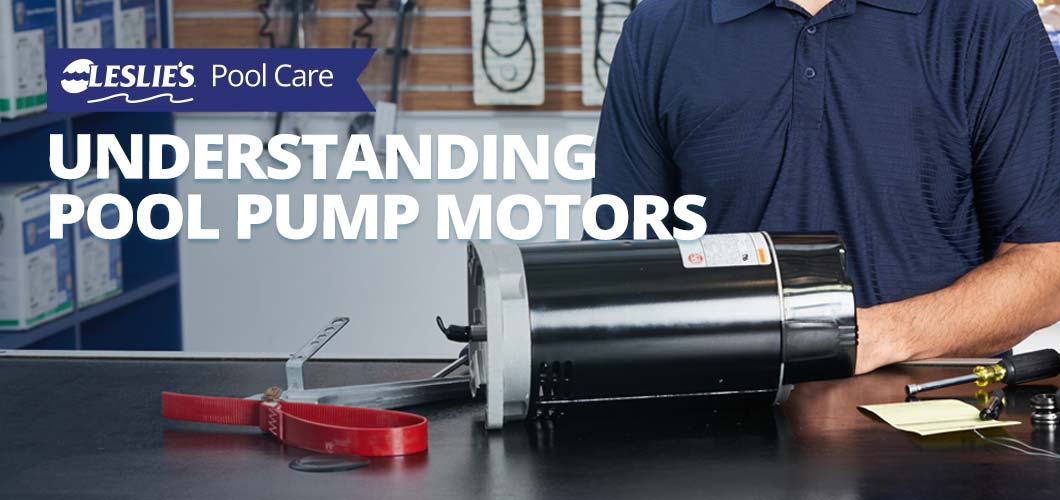
Understanding Pool Pump Motors
Your pool pump is the beating heart of your pool equipment setup, and keeps the water circulated and fresh. Having an efficient and powerful pool pump motor is critical to keeping your pump up and running. But with so many different pool pump motors out there, how do you know which one is best for your pump? Taking the time to find the right pool pump motor will extend the life of your pump — saving you time and money!
Pool Pump Motors 101
Pool pump motors are located on the "dry end" of the pump and convert electrical energy into mechanical energy. A motor’s main purpose is to power the pump’s impeller, the device that moves the water through the pump. A properly-sized and well-maintained motor can last 8–10 years. Conversely, poor conditions can cause a motor to fail after one year. Understanding some basic information about pool pump motors will help extend the motor's life and optimize performance.
What Type of Motor is a Pool Pump Motor?
Pool pump motors are classified as open drip proof. This means they have ventilation openings designed to prevent water from entering the motor. Not only does this prevent water damage, but it also allows adequate air flow for optimal function and to avoid overheating.
Single Speed vs. Dual Speed
A single speed pool pump motor runs at the same speed all the time, with no variation. While a dual speed motor has two settings: low and high. The low setting is best for basic, everyday pool circulation. And the high speed setting is great for vacuuming or operating water features. Dual speed pumps use less energy, extend the life of the motor, and save money on electricity bills.
Can I Upgrade from a Single Speed to a Dual Speed Pool Pump Motor?
This is a very common question, especially since dual speed motors are much more energy efficient than single speed. Accurately matching motors and pumps is key to ensuring they perform at their optimum efficiency. When upgrading to a new motor, verify the total horsepower (horsepower x service factor) of the new motor is greater than or equal to the total horsepower of the original motor.
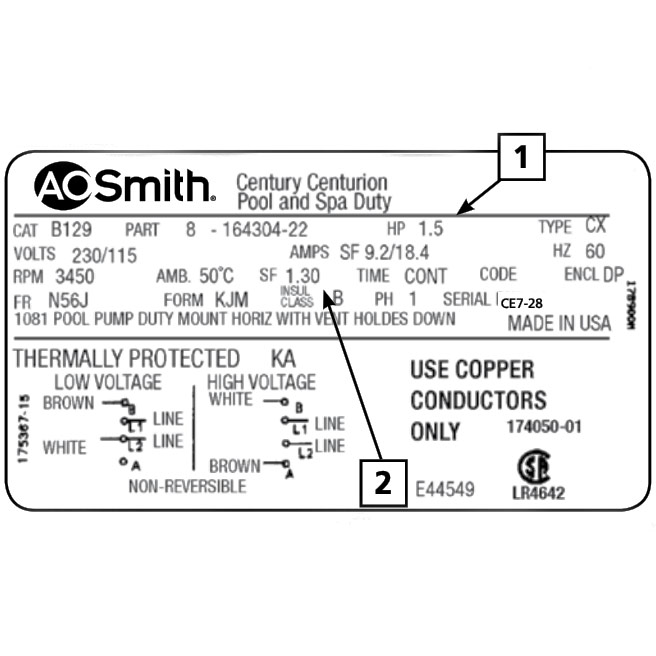
How to Read Your Pump Motor's Label
Every pool pump motor has a sticker or nameplate that provides important specifications, including: voltage, horsepower (1), Hertz rating, and service factor (2). The service factor measures the capacity at which the motor can operate without overload or damage. A motor’s effective horsepower, or total horsepower, is the actual power output of the motor.
Use the following equation to determine the total horsepower of your pool pump motor:
1.5 (Horsepower) x 1.3 (Service Factor) = 1.95 (Total Horsepower)
Types of Pool Pump Motor Frames
A quick look at your pump motor's label will tell you all you need to know about what type of motor you have. However, repeated exposure to the elements will likely render your pump motor's label illegible after a year or two. If this is the case, and you need to know what type of motor you have, refer to your owner’s manual for the information. But, if your manual is nowhere to be found, you can use the frame type to determine the motor's specifications. There are 4 types of pool pump motors, and each one has a specific frame configuration. Below are the descriptions of each type:
Thru-Bolt Frame:
The location of the mounting bolts is the key identifier for this style of motor. Thru-bolt motor frames, commonly used for hot tub and above ground pool pumps, fasten to the pump housing with bolts. These motors are sometimes labeled 48Y frames, but they are not to be confused with square flange 48Y frames, which we discuss below.
- Horsepower Rating: 0.5–3
- Voltage: 115, 120, 230, 240
- Service Factor: 1–1.50
- Speed: Dual and single
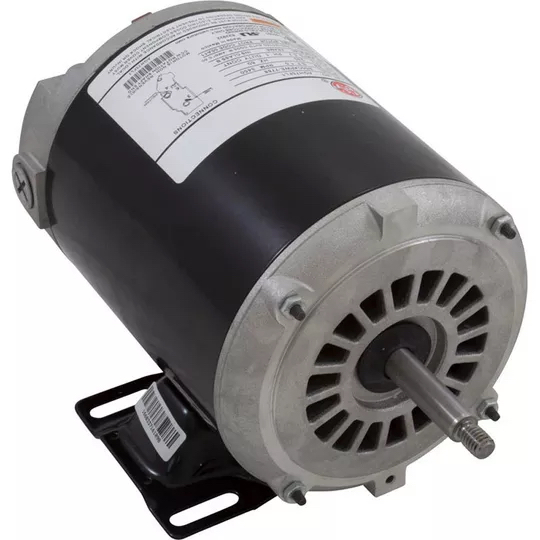
Square Flange Frame:
Square flange is the most common type of pool pump motor frame used today. These frames attach directly to the pump housing via mounting holes in the corners of the flange. Square flange frames are also referred to as 56Y or 48Y frames.
- Horsepower Rating: 0.5–5
- Voltage: 115, 120, 208, 230, 240
- Service Factor: 1–1.75
- Speed: Dual and single
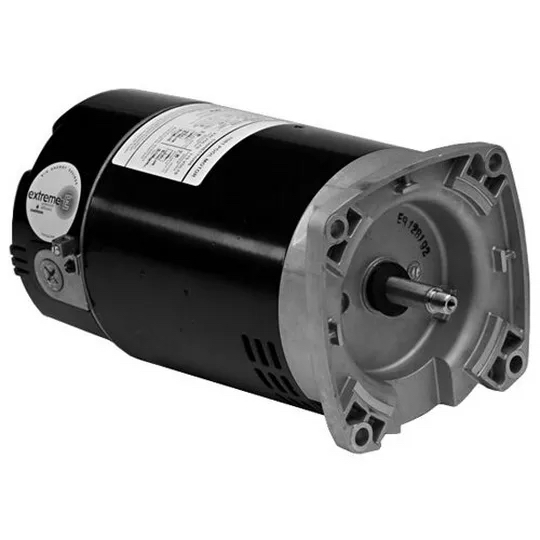
C-Face Keyed Frame:
Less common in today's market, C-face keyed frames have a slotted shaft that sits into the housing of older-style pumps. The notched flange holds the impeller in place with screws once it slides over the key-way. C-face keyed frames are also known as 56C keyed shaft frames.
- Horsepower Rating: 0.5–3
- Voltage: 115, 120, 208, 230, 240
- Service Factor: 1–1.50
- Speed: Dual and single
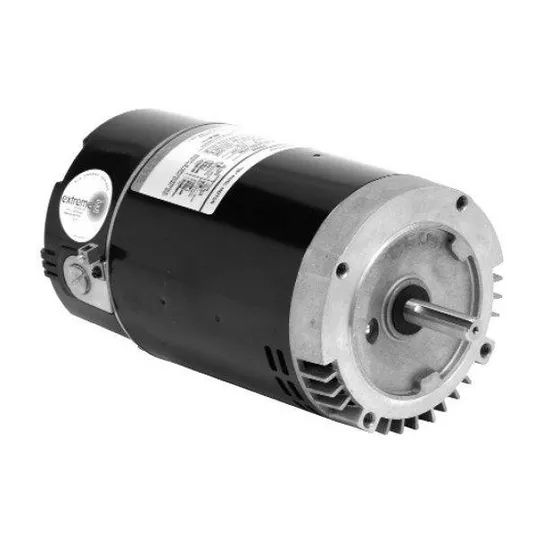
J-Face Threaded Frame:
J-face threaded frames mount onto the body of the pump, then the impeller is threaded onto the motor shaft. The impeller may be secured with a small screw, which is threaded into the center of the motor shaft. These frames are often referred to as 56J C-Flange frames.
- Horsepower Rating: 0.5–3
- Voltage: 115, 120, 208, 230, 240
- Service Factor: 1–1.50
- Speed: Dual and single
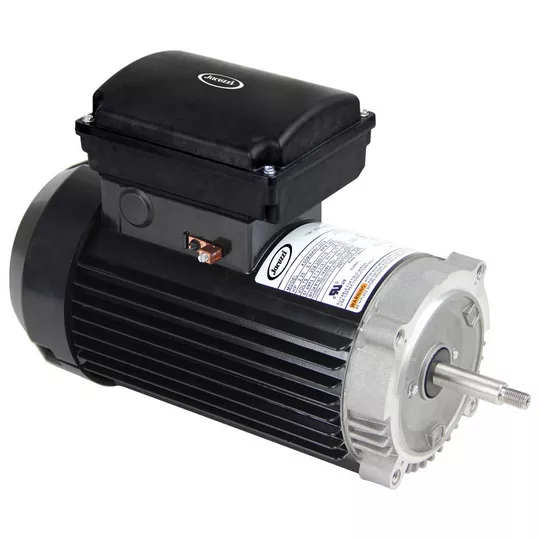
The Difference Between Full-Rated and Up-Rated Pump Motors
When shopping for a new pump motor, you will see motors described as either "full-rated" or "up-rated". These ratings describe the pump motor's service factor, which determines the motor's total horsepower. Full-rated motors have a high service factor, while up-rated motors have a lower service factor.
Pump motor manufacturers began up-rating motors in response to consumer perception that higher horsepower means greater efficiency. In reality, up-rated motors are relabeled with a higher horsepower rating and proportionally lower service factor rating. While the horsepower rating is higher, there is no increase in the motor’s power output.
Potential Pool Pump Motor Issues
Like any piece of pool equipment, pool pump motors are prone to damage caused by nature, poor installation, and poor maintenance. The best way to prolong the use and efficiency of your pump motor is to take proper care of it, starting from day one. Below are a few common problems pump motors can face, and the best ways to avoid them.
Incorrect Pump Size
To avoid pump motor problems, start at the beginning and verify your pool pump is the appropriate size for your pool and filter. An oversized pool pump puts excessive pressure on your filter, which decreases the effectiveness of the filter and affects the entire plumbing system. The longer this goes on, the harder the pump motor works, resulting in a premature break down of the motor. Ensure your pump is the proper size for your pool to keep your pump motor, and filter, running longer. Check out our blog post, Pool Pump Sizing 101, for expert advice on fitting your pool pump!
Exposure to the Elements
Because your pump motor stays outside all its life, it will inevitably experience rainstorms, strong winds, snow, and the blazing sun. While pump motors are designed to withstand the elements, limiting its exposure to severe weather will prolong its viability and efficiency. If you know a storm is on the horizon, cover your pump and motor, or even detach and bring the motor inside if possible.
Poor Maintenance
In addition to protecting your pump motor from the elements, it's also important to protect it from normal wear and tear. Keep O-rings lubricated and in working order, and clear debris from around the motor when necessary to extend the life and usefulness of the motor. Additionally, routinely backwash or clean the filter cartridges of your pump to maintain optimal performance. Remember, the pump and pump motor have a symbiotic relationship: if one is working well, the other will be healthier and happier for it!
Improper Installation
Even a perfectly matched motor won't work with your pool pump if it's not properly installed. Before turning on your new motor and pump, verify the voltage, size, and frame is correct. Our blog post "How To Replace a Pool Pump Motor" gives you all the information you need to know about replacing your pool pump motor.
A pool is nothing without a pump, and a pump is nothing without a pump motor. The right motor is key to maintaining an efficient pump, and a healthy pool. Whether you're replacing an old motor, or you just purchased a new pump system, Leslie's is here to help! You can schedule a service appointment online, or stop by your neighborhood store to speak with one of our pool experts.